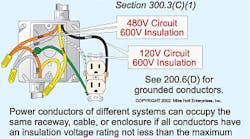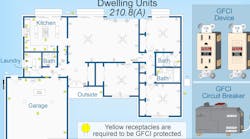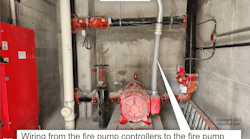After a small engine plant began experiencing severe power quality problems and the subsequent investigation showed the wireways weren't electrically continuous, the facilities team found the solution in the requirements of the Code, particularly Art. 300. Although it's primarily a life safety standard, the NEC can sometimes double as a blueprint for good system performance.
At its core, Art. 300 outlines requirements for proper wiring. However, in cases like the power quality situation at the small engine plant, it can double as a guideline for eliminating problems that can hurt your system's operation and efficiency.
Art. 300 requirements don't apply to signaling and communications systems, except where specifically mentioned. Nor do they apply to the internal parts of electric equipment. See 90.7.
Conductor requirements. Per 300.3, you must install individual conductors in a raceway, cable, or enclosure. Further, you must put all conductors of a circuit in the same raceway, cable, trench, cord, or cable tray, unless otherwise permitted, in accordance with 300.3(B)(1) through (4). This requirement minimizes inductive heating of metallic raceways and enclosures, and it reduces impedance should a ground fault develop.
Power conductors of different systems can occupy the same raceway, cable, or enclosure if all conductors have an insulation voltage rating not less than the maximum circuit voltage (Fig. 1). You must separate control, signal, and communications wiring from power and lighting circuits to prevent the higher voltage conductors from accidentally energizing them. Exceptions to this requirement allow power conductors to terminate to listed signaling equipment if the power conductors maintain at least a 0.25-inch separation from the low-voltage and limited-energy conductors.
Where cables and raceways are underground, apply the requirements of 300.5 and Table 300.5. To protect underground cables and conductors from damage, follow the requirements of 300.15.
Conductors in raceways must be continuous between all points of the system. This means you can't place splices in the raceway, except as permitted by 376.56, 378.56, 384.56, 386.56, or 388.56.
The removal of a wiring device, such as a receptacle, from multiwire branch circuits must not interrupt the continuity of the grounded (neutral) conductor. Therefore, you must splice the grounded (neutral) conductors together and provide a pigtail for device terminations (Fig. 2) — except for GFCIs and AFCIs, which won't work if pigtailed. The opening of the ungrounded or grounded (neutral) conductor of a 2-wire circuit during the replacement of a device doesn't cause a safety hazard, so you're not required to pigtail these conductors [110.14(B)].
A closer look at raceways. Use raceways, fittings, and supports that are suitable for the environment in which you'll install them. Where corrosion protection is necessary, such as underground and wet locations, and the conduit is threaded in the field, coat the threads with an approved electrically conductive, corrosion-resistant compound.
If condensation from temperature changes might be a problem, fill the raceway with a material approved by the AHJ to prevent the circulation of warm air to a colder section of the raceway or sleeve [300.7(A)]. An explosionproof seal isn't required for this purpose (Fig. 3 above).
You must provide raceways with expansion fittings where necessary to compensate for thermal expansion and contraction [300.7(B)]. Table 352.44(A) provides the expansion characteristics for PVC rigid nonmetallic conduit. To determine the expansion characteristics for metal raceways (EMT, IMC, and RMC), multiply the values from Table 352.44(A) by a multiplier of 0.20 [300.7(B) FPN].
If you use an expansion fitting with a metal raceway, you must use a bonding jumper to maintain the equipment-grounding path (250.98). Join all metal raceways, cable, boxes, fittings, cabinets, and enclosures to form a continuous low-impedance ground-fault current path (300.10). The ground-fault current path must have adequate capacity to carry any fault likely to be imposed on it [110.10, 250.4(A)(3), and 250.122].
Raceways are designed for the exclusive use of electrical conductors and cables, and can't contain nonelectrical components, such as lines for steam, water, or gas. Raceways and cable sheaths must be mechanically continuous between terminations (300.12). However, the Code doesn't require short lengths of metal raceways used for cable protection or support to be electrically continuous, mechanically continuous, or bonded.
Securely fasten in place raceways, cable assemblies, boxes, cabinets, and fittings. You can't use ceiling support wires or the ceiling grid to support raceways or cables.
You can support electrical wiring within the cavity of a floor-ceiling or roof-ceiling assembly to independent support wires that are secured at each end. If this cavity is fire-rated, the support wires must be distinguishable from the suspended ceiling support wires by color, tagging, or other effective means. If this cavity isn't fire-rated, the support wires don't have to be distinguishable from the suspended ceiling support wires. You can support outlet boxes [314.23(D)] and luminaires to the suspended ceiling if you securely fasten them to the ceiling-framing member [410.16(C)].
You can't use raceways to support other raceways, cables, or equipment. However, you can support Class 2 and 3 cables with the raceway that supplies power to the equipment controlled by the circuit. Because Class 2 and 3 cables can't be installed in the same raceway with the power conductors [725.55(A)], the next best thing is to attach them to the raceway (725.58 and Fig. 4 on page 50).
You can't use type AC, NM, or MC cable to support other cables, raceways, or nonelectrical equipment. However, you can use raceways to support threaded boxes, conduit bodies [314.23(E) and (F)], and luminaires [410.16(F)].
If the vertical rise of a raceway exceeds the values of Table 300.19(A), support the conductors at the top or as close to the top as practical. The weight of long vertical runs of conductors can cause the conductors to drop out of the raceway if you don't secure them properly. In several instances, conductors located in a vertical raceway were released from the pulling basket (at the top) and fell down and out of the raceway.
You must install electrical circuits and equipment in a way that doesn't substantially increase the possible spread of fire or products of combustion. This means sealing openings in fire-rated walls, floors, and ceilings for electrical equipment. Use fire-stop material listed for the specific types of wiring methods and construction structures.
In general, you must keep wiring and air handling separate, but you can wire in environmental air space under certain conditions listed in 300.21(C). The NEC doesn't place any restrictions on wiring methods in spaces not used for environmental air-handling purposes, so you can use nonplenum cables in those locations.
The primary benefit of following the requirements of Art. 300 is the safeguarding of people and property. But these requirements also reduce conductor failure rates and increase operational efficiency. For power quality problem prevention, the requirements of Art. 300 rank second only to those of Art. 250.








